Tick Season is Here — How to Stay Bite-Free This Summer

If you’re spending more time outside this summer — whether it's backyard BBQs, trail hikes, or cottage weekends — here’s your seasonal reminder: tick season is in full swing, and these tiny bugs are packing more than just a creepy crawly factor.
As of mid-May, over 1,000 Lyme-disease carrying blacklegged ticks have already been reported in Ontario this year. And while that number may not sound huge, it only takes one bite to completely derail your summer plans — or worse, impact your long-term health.
So, what’s the big deal with ticks?
Ticks can transmit Lyme disease, a bacterial infection that can cause fatigue, joint pain, rashes, and in more serious cases, neurological issues and long-term complications. It’s treatable if caught early — but once it spreads through your body, treatment becomes trickier and symptoms can linger for months or even years.
Ticks don’t fly or jump — they latch on when you brush past them in tall grass, bushes, or wooded areas. That’s why awareness and prevention are key.
How to protect yourself from tick bites:
Cover up: When hiking or working in the garden, wear long sleeves and pants. Tuck your pants into your socks (yes, it’s a fashion statement — for survival). Light-coloured clothes make it easier to spot ticks.
Do tick checks: After being outside, especially in grassy or wooded areas, check your entire body — scalp, behind ears, belly button, armpits, and groin. Ticks love warm, hidden spots. Showering can help dislodge them too.
Use insect repellent: Look for products with DEET or icaridin, both effective at keeping ticks away.
Don’t forget your pets: Dogs are tick magnets. Use vet-approved tick prevention and check their fur regularly — especially after walks.
Keep your yard tidy: Ticks love long grass and shady brush. Mow the lawn, clear leaf litter, and create a barrier between wooded areas and your home.
Found a tick?
Remove it ASAP using fine-tipped tweezers. Grab as close to the skin as possible, pull straight out (slow and steady), and clean the area. Save the tick in a sealed bag with the date/location and store it in your freezer. If symptoms show up later, your doctor may be able to test the tick.
The scary part? Tick numbers — and Lyme disease cases — are climbing, and climate change is helping them spread further and stick around longer. So, even if you live in an area that didn’t used to have ticks, it’s wise to be on alert.
Ticks may have been around since the dinosaurs (seriously!), but that doesn’t mean we can’t outsmart them. With a little prep and a lot of awareness, you can still enjoy the great outdoors — safely and bite-free.
Check out eTick.ca to report ticks or see where they’ve been found in your area.
Beat FOMO by being in the know!
Sign up for our newsletter today and never miss a beat.





